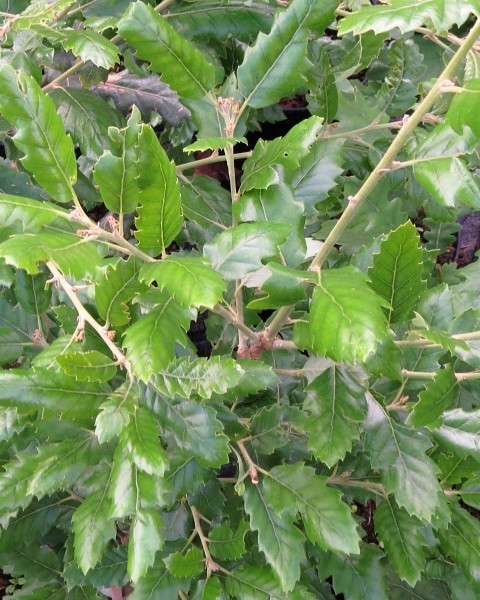Macedonian oak
(Quercus trojana)

Description
Quercus trojana, the Macedonian oak is an oak in the 'turkey oak section' (Quercus sect. Cerris). It is native to southeast Europe and southwest Asia, from southern Italy east across the southern Balkans to western Turkey, growing at low to moderate altitudes (up to 1550 m in the south of the range in southwestern Turkey), in dry areas. Quercus trojana is a small to medium-sized tree reaching 10–20 m tall, late deciduous to semi-evergreen, with grey-green leaves 3–7 cm long and 1.5–4 cm broad with a coarsely serrated margin with sharply pointed teeth. The acorns are 2–4 cm long when mature about 18 months after pollination, and largely enclosed in the scaly acorn cup. Fossils of Quercus trojana have been described from the fossil flora of Kızılcahamam district in Turkey, which is of early Pliocene age. An oak is a tree or shrub in the genus Quercus (""oak tree"") of the beech family, Fagaceae. There are approximately 500 extant species of oaks. The common name ""oak"" also appears in the names of species in related genera, notably Lithocarpus (stone oaks), as well as in those of unrelated species such as Grevillea robusta (silky oaks) and the Casuarinaceae (she-oaks). The genus Quercus is native to the Northern Hemisphere, and includes deciduous and evergreen species extending from cool temperate to tropical latitudes in the Americas, Asia, Europe, and North Africa. North America has the largest number of oak species, with approximately 160 species in Mexico of which 109 are endemic and about 90 in the United States. The second greatest area of oak diversity is China, with approximately 100 species. Oaks have spirally arranged leaves, with lobate margins in many species; some have serrated leaves or entire leaves with smooth margins. Many deciduous species are marcescent, not dropping dead leaves until spring. In spring, a single oak tree produces both male flowers (in the form of catkins) and small female flowers, meaning that the trees are monoecious. The fruit is a nut called an acorn or oak nut borne in a cup-like structure known as a cupule; each acorn contains one seed (rarely two or three) and takes 6–18 months to mature, depending on their species. The acorns and leaves contain tannic acid, which helps to guard from fungi and insects. The live oaks are distinguished for being evergreen, but are not actually a distinct group and instead are dispersed across the genus.
Taxonomic tree:







